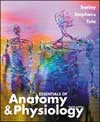 |  Essentials of Anatomy & Physiology, 4/e Rod R. Seeley,
Idaho State University
Philip Tate,
Phoenix College
Trent D. Stephens,
Idaho State University
Introduction to the Human Body
Study Outline
Anatomy
Physiology
Structural and Functional Organization - Levels of Study (Fig. 1.1, p.
3 )Chemical
Organelle
Cell
Tissue
Organ
Organ system(Fig. 1.2, p. 4-6)Organism
Characteristics of Life
Organization
Metabolism
Responsiveness
Growth
Differentiation
Reproduction
Homeostasis(Fig. 1.3, p. 7)Negative-feedback mechanisms(Fig. 1.4, p. 8)Positive-feedback responses(Fig. 1.5, p. 9) Terminology and the Body Plan
The Anatomical Position
Directional terms (Table 1.1, Fig. 1.6 p. 10)Superior and inferior
Anterior (ventral) and posterior (dorsal)Proximal and distal
Medial and lateral
Superficial and deep
Planes of section of the body(Fig. 1.7, p. 11)Sagittal and midsagittal sections
Transverse section
Frontal or coronal section
Planes of section of an organ(Fig. 1.8, p. 12)Longitudinal sections (sagittal or frontal)Transverse section
Oblique section
Body regions(Fig. 1.9, p. 13)Head
Neck
Trunk
Thorax
Abdomen (quadrants or regions)(Fig 1.10, p. 14)Pelvis
Limbs
Body cavities(Fig. 1.11, p.14)Thoracic Cavity and Mediastinum
Abdominal cavity
Pelvic cavity
Serous membranes and serous fluid(Figs. 1.12, 1.13, p. 15)Parietal and visceral pericardium
Parietal and visceral pleura
Parietal and visceral peritoneum
Mesenteries
Retroperitoneal organs
|
|



 2002 McGraw-Hill Higher Education
2002 McGraw-Hill Higher Education